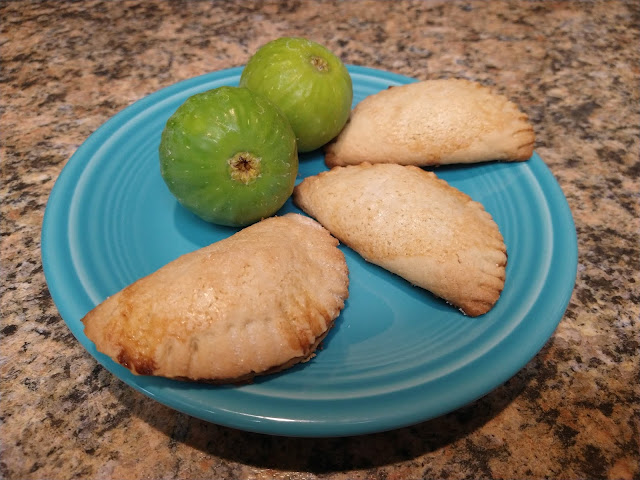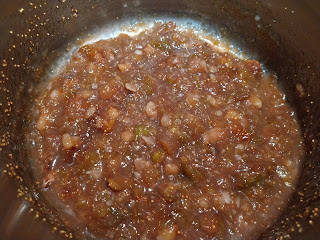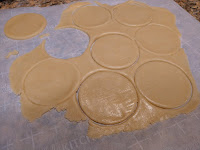
Recipe: Fig pockets are filled with quick fresh preserves

|
Like fig season, these cookies are special. They take a little time and effort, but the results are delicious with a delicate crispness and just the right amount of fig.
Filled with quick fresh fig preserves, they’re like mini turnovers. Instead of a flaky crust, the golden pastry forms something closer to a scone. Removed from the oven at 8 minutes, the dough stays soft like a thick sugar cookie with a fig center. Two minutes more, the top is golden and the bottom crisps while the filling retains its softness. (Any longer and the cookie gets too crunchy.)
The pastry dough needs to be kept as cold as possible; otherwise, it sticks to everything while being worked and pulls apart. So, make these little pastry pockets in batches of 10 or 12.
 |
|
| Quick fresh fig preserves double as filling. |
For the fig filling, finely chop the figs including skin. (The food processor is great for this.) Walnuts add a little extra texture and flavor, but are optional. You’ll have extra fig filling leftover. Use those quick fig preserves on toast or English muffins. Or make more cookie dough!
Fig pockets
Makes about 30 cookies
For pastry:
6 tablespoons shortening
¾ cup sugar
2 eggs, lightly beaten
¾ teaspoon vanilla
2 cups flour
½ teaspoon salt
¼ teaspoon soda
For filling:
1-1/2 cups figs, finely chopped (about ½ pound)
2/3 cup sugar
2/3 cup water
1/3 cup walnuts, finely chopped (optional)
To assemble:
1/4 cup milk
3 tablespoons sugar
Prepare pastry dough. With a pastry blender in a large bowl, cut ¾ cup sugar into shortening until fluffy. Stir in eggs, then vanilla. Sift together flour, salt and soda. Blend dry ingredients into sugar-shortening mixture. Cover bowl with plastic wrap and chill dough in refrigerator for 1 hour.
Prepare filling. In a heavy saucepan, combine chopped figs, 2/3 cup sugar, water and walnuts, if desired. Over medium heat, bring mixture to a boil, then reduce heat to simmer. Stirring often to prevent sticking, cook fig mixture until it thickens, about 10 to 15 minutes depending on the ripeness of the figs. Remove from heat and let cool thoroughly.
Preheat oven to 400 degrees F.

|
Remove chilled dough from refrigerator. Divide dough into thirds. Put one third of the dough on a sheet of parchment paper or lightly floured, cloth-covered board. Return remaining dough to refrigerator to stay cold.
Between two sheets of parchment paper or on the lightly floured board, roll dough until thin, about 1/16th inch thick. Using a 3-inch cookie cutter or the rim of a large glass, cut circles of pastry. Place 1 teaspoon of fig filling on each pastry circle. Fold pastry over filling. Use a fork to crimp the pastry and seal.
Carefully place little turnovers onto an ungreased baking sheet, leaving plenty of room between each cookie. Brush tops with milk and sprinkle with sugar.
Bake at 400 degrees for 8 to 10 minutes, or until very light golden brown. (Less for a softer cookie, longer for a crisper cookie.) Remove cookies from baking sheet immediately and cool on a rack.

|
Repeat this process until all dough is used.
These cookies can be served warm or room temperature. Store in a sealed container.
Comments
0 comments have been posted.Sacramento Digs Gardening to your inbox.
Sites We Like
Garden Checklist for week of July 21
Your garden needs you!
* Keep your vegetable garden watered, mulched and weeded. Water before 8 a.m. to reduce the chance of fungal infection and to conserve moisture.
* Feed vegetable plants bone meal, rock phosphate or other fertilizers high in phosphate to stimulate more blooms and fruiting. (But wait until daily high temperatures drop out of the 100s.)
* Don’t let tomatoes wilt or dry out completely. Give tomatoes a deep watering two to three times a week.
* Harvest vegetables promptly to encourage plants to produce more. Squash especially tends to grow rapidly in hot weather. Keep an eye on zucchini.
* Pinch back chrysanthemums for bushy plants and more flowers in September.
* Remove spent flowers from roses, daylilies and other bloomers as they finish flowering.
* Pinch off blooms from basil so the plant will grow more leaves.
* Cut back lavender after flowering to promote a second bloom.
* It's not too late to add a splash of color. Plant petunias, snapdragons, zinnias and marigolds.
* From seed, plant corn, pumpkins, radishes, winter squash and sunflowers.